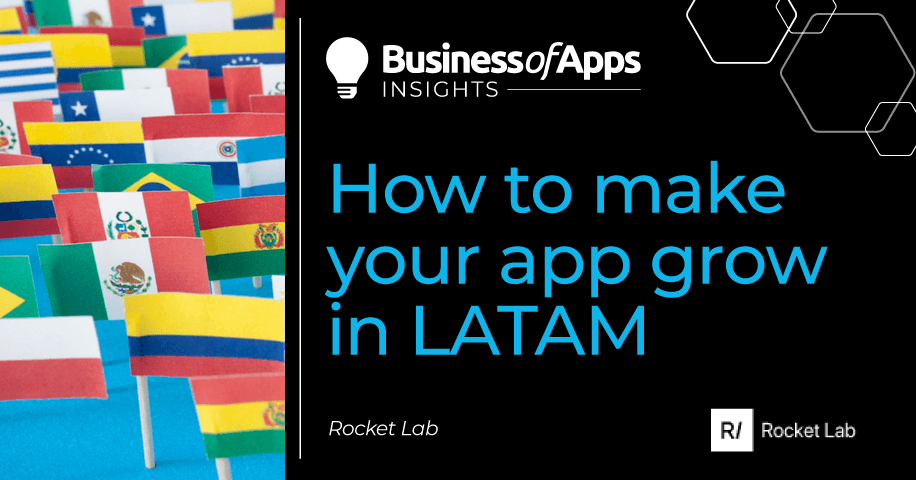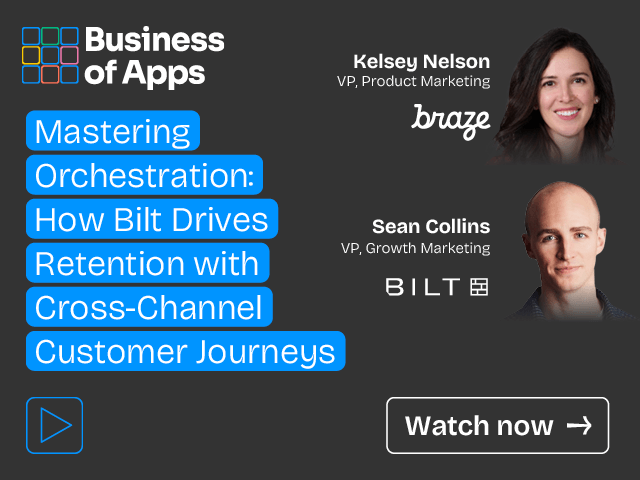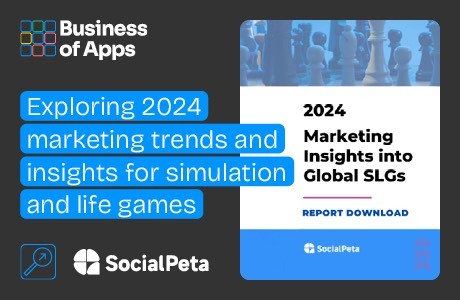Latin America (LATAM) is one of the fastest-growing mobile app regions in the world. It is also a very diverse region with its own political and social factors that affect the mobile economy.
Let’s start with the fact that 54% of Latin Americans have been using more apps since the Covid-19 pandemic and spend 18 times more time on apps than on websites. The potential of Latin America is immense. Coupled with untapped customer supply, the region is increasingly emerging as an ideal investment location.
LATAM has a wide range of new and fragmented markets, so apps aiming to make a profit in this region will need deep knowledge and understanding of the operational challenges and required solutions.
In this blog post, we share some insights and key points to consider to grow your app and ultimately your business.
Acquisition
Let’s start with the basics. Whether you’re launching an app or switching web traffic to your app, there are ways to encourage users to download your app. To achieve this, it is important that users understand the value of their purchase, and that your product has a product-market fit. Put simply, your app has to solve a specific problem for users, it has to be useful to them, aka deliver value.
Retention
40% of LATAM users uninstall an app after 30 days. Competitors are just a click away, and in an era where great experiences are not the norm, many apps spend their marketing budgets to attract customers, but most manage to frustrate customers with poorly designed experiences. That’s why it’s important to make sure your app provides a good user experience.
What to measure and how
What is not measured is rarely improved. Therefore, measurement is key to evaluating the performance of an app. It’s true that reaching new users is the first step in growing your app, but it’s also important to look at the right metrics to understand what happens after the first install. In your strategy, among other basic data, you need to know how many users downloaded it, how many users carried out actions, and what the conversion rate is.
Apps have become an important resource in people’s lives and, at a time when the demand for greater privacy by users is transforming the digital ecosystem, having your own data is essential for the success of your brand. Interacting with consumers through the app will allow you to quickly collect data and spot trends.
There are a variety of metrics that can effectively determine the strengths and weaknesses of your in-app advertising strategy as well as its overall performance.
These include, among others, CTR (click-through rate), which is the percentage and number of users who clicked on a particular link (in this case, an in-app ad) and CPL (cost per lead) generated. To get your CPL, simply divide the investment in a particular ad by the number of leads directed at marketing and sales.
Deep links
Deep links allow you to place links that direct users to specific locations within your app, making it easy for them to find what they’re looking for. It not only makes life easier for users but also improves the performance of ads. On average, these types of campaigns generate double the conversion rate in LATAM. You can also use data-driven attribution to see which of your active ads are converting.
Growth of advertising in-app ads
Latin America surpassed 1.3 billion mobile app downloads in the first quarter of 2021 on both iOS and Google Play, according to data from AppsFlyer. Compared to the United States, the report noted that “Mexico and Spanish-speaking countries in Latin America outperformed the download market, showing strong year-over-year growth.”
This definitely shows the potential of advertising in apps, especially in mobile games, social networks, and messaging applications. The first is the most popular. Second and third place are due to the largest number of active users (Facebook is the leader in LATAM, followed by WhatsApp). Colombia, Brazil, Argentina, Mexico, and Chile are the markets where TikTok, which has gained a lot of momentum recently, ranks first in terms of downloads.
Localize your app
Latin America has 20 countries and 13 dependencies, making it one of the most diverse regions in the world. The languages spoken in most of these countries are Spanish and Portuguese, but there is even more diversity as there are both English-, French-, and Dutch-speaking regions.
However, language is just one aspect of localization. Another is the locals’ favorite sports, leagues, and competitions. Latin Americans are big soccer fans, to take one example.
Payment methods
Payment statistics in Latin America vary greatly by country and region. For example, in Brazil, unlike those living in the south, most adults in the north do not have access to financial services such as debit cards, credit cards, or even bank accounts.
Latin America may not have the same market access as other countries like the US or member states of the EU. Local financial institutions, payment networks, and fintech companies are, therefore, more popular than international ones.
Consumers are getting used to digital wallets and contactless mobile payments, even though the region remains largely unbanked and cash transactions remain predominant. Several Latin American countries are developing, adapting, and innovating alternative payment methods for citizens without access to financial services. As a result, fintechs, banks, and even governments are increasingly adopting digital payments to enhance financial inclusion in the region.
It is important to understand the payment preferences of your users and offer them the options that are known to them in their country and that are most beneficial for their current situation. This enhances the user experience and builds trust.
Top mobile platforms to advertise on
AppsFlyer, the marketing experience and measurement platform, has released the 14th edition of its Performance Index (PI), so let’s have a look at some of its findings.
Meta Ads ranked first in the SKAdNetwork (SKAN) index, which measures in-app engagement, purchases (IAPs), and advertising, according to the report.
TikTok For Business ranked second, dropping one place compared to last year. Despite the decline, it is still one of the most popular advertising tools out there. It ranks second in power and volume for non-gaming apps and second in power for the IAP index for gaming.
Meanwhile, Google maintains its dominance on Android. Before and after Apple’s privacy changes, the search giant dominated iOS too, ranking first in power and in a number of IAPs as well as retention.
Gaming
When it comes to trends, there are several reasons why we can expect esports to grow in Latin America in the coming years. The main reason is the emergence of strong teams in the region in games like Dota 2, League of Legends, and Counter-Strike: Global Offensive (CS:GO).
The region has already hosted several tournaments, with Mexico hosting a play-in event for the League of Legends World Championship.
In many parts of the world, esports is already developing at a rate that rivals traditional sports. Latin America may not be the most prominent esports market right now. However, this market should not be overlooked with the expansion of teams, general popularity and number of tournaments in the region.
AVOD in LATAM
The GSMA report classifies LATAM as a world leader in terms of user engagement with mobile services, especially entertainment and multimedia content consumption. According to the company’s research, 58% of users in Brazil and 67% of users in Mexico watch free videos on their mobile devices at least once a day. In contrast, in the United States, the number is just under 39%.
Taking the above into account, experts agree that AVOD (advertising-based Video on Demand) remains a popular format in Latin America. AVOD gives users free access to multimedia content while watching advertisements. YouTube is the leader in this format, followed by video game apps. Subscription streaming services, very popular in LATAM, can also offer similar options.
ComScore’s 2021 report, “State of Social Media in Latin America” shows that 84% of advertisers prefer the vertical format due to its high engagement rate. 58% of interactions are generated by vertical video. Additionally, persistent interaction through stories is encouraged to enable meaningful connections with users. Furthermore, 70% of Latinx users feel that they are not included in the AVOD guidelines.
WhatsApp as a conversion channel
When looking at the most-used instant messaging apps in the region, WhatsApp ranks first, followed by Facebook Messenger, Skype, Snapchat, Telegram, and others. More than 90% of Latin Americans use WhatsApp.
Latin American media, businesses, and public institutions have adopted WhatsApp as a means of direct communication with their customers. The impact of WhatsApp in the daily lives of Latin Americans is increasingly evident. WhatsApp is an important conversion and loyalty channel for marketers.
WhatsApp does not allow advertising in the app, but with WhatsApp Business, marketers can have a direct communication channel with their customers. For example, marketers can share a catalog of products, support, and/or services through a company’s WhatsApp profile.
Influencer marketing potential in LATAM
According to ComScore (2021), influencer posts represent 6.5% of all posts in Latin America. Even more shocking, influencers were responsible for 52% of interactions in the region.
In Latin America, there are at least 12 million influencers, according to data from the firm Influencity specialized in linking brands with content creators. It should be noted that this data refers to influencers on Instagram:
- 95.6% of content creators for Instagram in LATAM are nano-influencers (between 1 and 1000 followers).
- 3.7% of Instagram content creators in LATAM are micro-influencers (10 to 50,000 followers).
- 0.5% of content creators for Instagram in LATAM are medium influencers (between 50 and 200,000 followers).
- 0.1% of content creators for Instagram in LATAM are macro-influencers (up to 1,000,000 followers).
- A very small percentage of Instagram content creators in LATAM are mega-influencers (> 1,000,000 followers).
Now, the most recommended practice is to rely on small influencers, either by contacting them directly or through intermediary platforms.
Apps need to assess the social platform with the greatest impact for their target audience before considering reaching out to influencers. TikTok, for example, has experienced a boom in Latin America in the last year, with a vast number of famous “Tiktokers”; however, 32.5% of TikTok’s audience in Latin America consists of young people between the ages of 10 and 19, and the platform’s content is mainly entertainment.
For their part, Facebook, YouTube, and Instagram continue to be the most used social networks by both men and women of all ages.
Regulations
When it comes to iGaming legislation, most South American governments are ramping up their attempts to legalize, regulate, and tax the increasingly popular iGaming sector.
Countries like Argentina and Uruguay are at the forefront of enacting practical gambling regulations that local economies can benefit from while reducing the negative effects of illegal gambling.
Bolivia and Ecuador, on the other hand, still adhere to rules established over a century ago, usually by religious leaders, resulting in a devastated national gaming industry.
Meanwhile, countries like Brazil are closing the gap by enacting laws that modernize their laws despite opposition from conservatives who resist change and prefer clinging to the old ways.
Conclusion
Latin America has a lot of untapped business potential, but there are some challenges that new and expanding applications are likely to face. Having a trusted partner who knows the market can help drive your success and growth in such a particular region. Rocket Lab has invested in the development of solutions to ensure your success in the vast and diverse consumer market of LATAM with state-of-the-art technology. Their experienced teams have the knowledge and skills to help you navigate the complexities of the LATAM market and scale your app successfully without a hitch.












